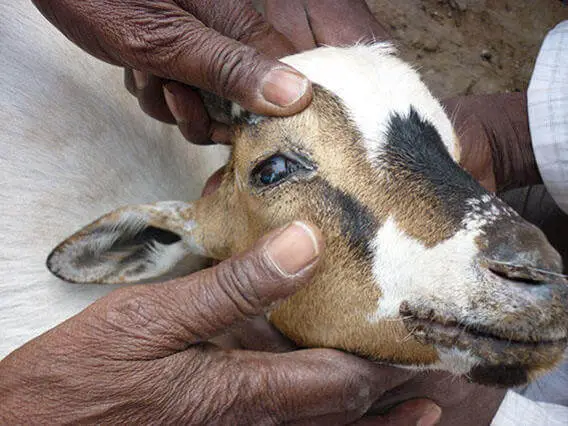PPR is a life threatening disease in goats. The disease is caused by a virus called Peste des Petits Ruminants (PPR). In this disease, fever, sores on the face, thin stools and shortness of breath are seen in the sick animal. Many times the sick animal can die.
In the words of scientists, it is a morbillivirus whose family is the paramyxovirus. The disease can occur in various cattle and some wild animals.
However, the disease is more common in goats and sheep. The disease was first reported in Ivory Coast in 1942. They used to call this disease kata. In 1986, zoo animals were attacked in the United Arab Emirates.
This is the first record of a goat being attacked by an animal other than a sheep. The disease was detected in the bodies of gazelles, wild goats and gemsboks at the zoo. The disease was first reported in China in 2006. The disease was first identified in 2006 in Morocco.
How is the disease spread?
- The disease can be spread through the eyes, nose, mouth secretions, faces, etc. of sick animals.
- Animals that come in contact with sick animals can infect healthy animals through breathing.
- The disease can also infect healthy animals through sneezing and coughing of sick animals.
- The disease can also be spread through water, food containers and furniture used by sick animals.
- Animals that have germs in their body but have not yet shown symptoms of the disease can transmit the disease from one place to another.
- However, the hope is that the germs of this disease cannot survive outside the body for long.
What are the symptoms of this disease?

- The symptoms of common PPR disease appear within 3-6 days of entering the body.
- Body temperature can suddenly rise a lot. These temperatures can range from 105 degrees to 106 degrees Fahrenheit.
- The goat’s nose, mouth, and eyes are the first to produce a thin liquid. Later it becomes thick and yellow. Gradually it can dry out and close the nostrils. This can cause shortness of breath in the animal.
- The eyes of the sick animal can also be affected by this disease. In that case, the goat’s eyelids may swell. Many times the eyelids may close due to the secretion of dense granular material.
- At one stage of the disease, the face may become swollen. The soft tissues inside the mouth may be affected. The flesh at the base of the teeth can cause muscle sores. In addition, gaps can form in the middle of the teeth, inside the mouth, on the palate, on the lips, on the tongue.
- Severe diarrhea can often occur in a sick animal. Diarrhea causes a lot of fluid to leak out of the body. As a result, the animal suffers from dehydration. The animal may also die due to the lack of water.
- The sick animal loses weight. The animal is slowly drying up.
- In goats infected with PPR, shortness of breath occurs within a few days of becoming ill.
- The animal may die within five to ten days of becoming ill.
- If the infected goat is pregnant, there is a possibility of miscarriage.
- Younger animals are more susceptible to this disease.
- The disease is more prevalent in goats than in sheep.
How to control the disease?
- Sick animals should be treated separately.
- Care should be taken to ensure that the fluid discharged from the nose, mouth and eyes of the sick animal does not get into the body of other animals.
- Goat houses should be cleaned with disinfectant.
Treatment:
- There is no specific treatment for PPR. However, the death rate can be reduced by preventing stage 2 bacterial and parasitic infections through the application of drugs.
- Oxytetracycline and chlortetracycline are very effective in preventing stage 2 respiratory infections.
- Studies have shown that food therapy and antibiotics such as enrofloxacin, safety four doses of good results.
- Washing the face with 5% boro-glycerin makes the mouth ulcer much better.
- However, around the eyes, nose, mouth should be cleaned with a clean cloth and cotton tube 2-3 times a day.
- Sick goats should be isolated as soon as possible.
- You need to contact the nearest livestock department immediately and seek the advice of a doctor.
- If the sick animal dies, it must be buried or cremated.
Pro Tips: In order to get good results in this treatment, you need to ensure the use of standard compliant serum. Under no circumstances should an opaque or cloudy serum be used. Intravenously apply a very warm (350 – 360 – C) vein with extreme caution, otherwise adverse reactions may occur.
Resistance:
The best way to prevent PPR is to vaccinate goats and sheep regularly. In this case, PPR vaccine is officially provided in every Upazila Livestock Department. Interested farmers can collect PPR vaccines from that department.
Conclusion:
Various studies have shown that this integrated approach is very effective in treating PPR. At different stages of the infection, from the highest 90 percent to the lowest 80 percent of the animals have recovered with this treatment.
In addition, the body of an animal that recovers from this disease develops immunity against PPR disease. The serum of all these animals can later be used in PPR treatment. Field level veterinarians and goat farmers can use this treatment method very easily.





